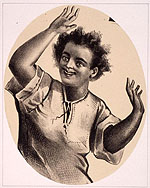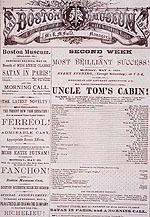
TO SEE SAMPLE
PROMPTBOOK PAGES:







The Boston Museum had been periodically staging Uncle Tom's Cabin for almost exactly as long: it was at this theater that H. C. Conway's dramatization, the one that P. T. Barnum brought to New York to compete with Purdy's show, premiered in late 1852.
Whenever the Boston Museum showed Uncle Tom, it used the Conway script, which featured, for example, William Warren's popular impersonation of an added character named "Penetrate Partyside" and an elaborate panorama of the Mississippi. Whenever Mrs. Howard misbehaved as Topsy, as she did thousands of times, it was in the adaptation of the novel written for the Howards by her cousin, George Aiken. In the 1850s, anti-slavery critics saw irreconcilable differences between Aiken's and Conway's re-presentations of Stowe's novel. For this production, however, presumably to accomodate both the expectations of the Museum's audiences and the convenience of Mrs. Howard, a composite was made of the two dramatizations: Conway's 5-act text was used for all of Acts 1, 2, 5 and 6, and the first half of Act 3; the remainder of Act 3 and all of Act 4 followed Aiken's text. Topsy has a few lines in Act 5, but at the start of the act the prompter's note reads: "Mrs. Howard plays the Scenes as they are in this act."
After the 2-week engagement at the Museum, the Howards decided to take this show with them when they went to New York's Park Theatre for a 3-week run that began May 22, 1876. In ADVERTISEMENTS for the production they referred to this hybrid script as "a new version" of the play "adapted to the sentiments of the times" and intended to commemorate the American Centennial then being opened in Philadelphia. Only one review of it, in the June 3 Clipper, even notices that changes have been made in the cast, &c. From the other reviews, and the length of the run, it was clearly a hit with New York audiences too, but there's no evidence the Howards ever again used it. The next time they played New York, at the Grand Opera House in October, it was with a different "new version" of Aiken's script, apparently a collaboration between G. C. Howard and J. P. Smith, that can be called the first "Tom Show."
The promptbook below is composed of three different "versions" of the play: a manuscript of most of Conway's script (written in several different hands), pasted-in pages from French's published edition of Aiken's script, and the many notes and cancellations made by the manager/prompter for this production. You can see the published Aiken text by CLICKING HERE. The Conway text was never published, but the archive contains a digital edition of the promptbook's handwritten scenes HERE. The text below offers a digital version of the promptbook itself, including the prompter's notes, cancellations, interpolations, etc.
The original promptbook is in The Howard Collection, Performing Arts Collection, Harry Ransom Humanities Research Center at the University of Texas, Austin; all rights reserved.

